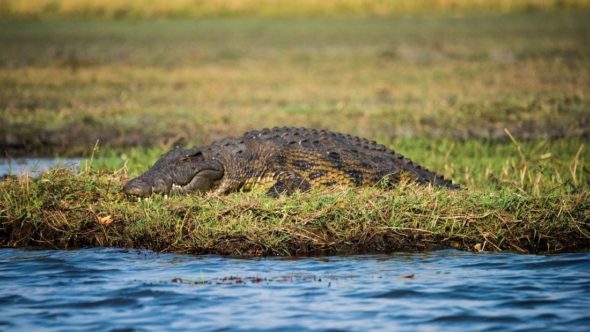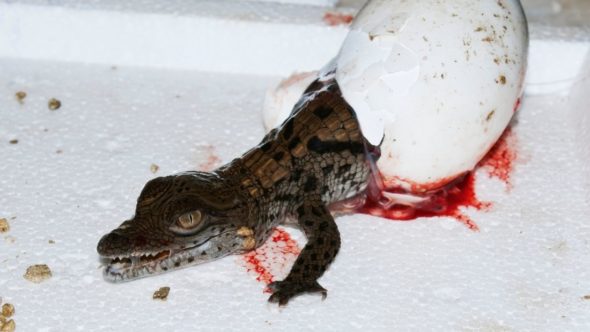How Crocodiles Are Farmed and Killed
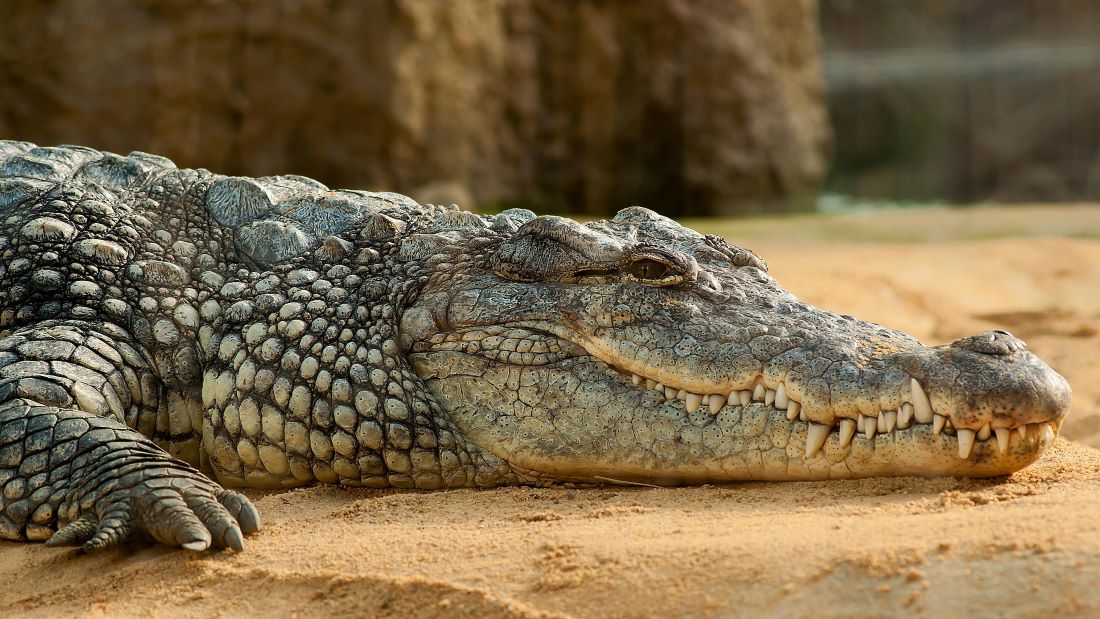
- Eight species of crocodile are capable of galloping to reach their top speed in a similar way to horses – and it dates back to the first crocodile species ever to appear on our planet. Alligators and caimans, on the other hand, can only trot.1Delvin, H.,2019. See you later, trotting alligators – many crocodiles can gallop. The Guardian. 17 December. Available at https://www.theguardian.com/science/2019/dec/17/see-you-later-trotting-alligators-many-crocodiles-can-gallop [Accessed 8 June 2020].
- Crocodiles have special salt glands on their tongues which enable them to live in saltwater. Any excess salt in their body from the water is secreted through what are modified salivary glands.2Bradford, A., 2014. Crocodiles: Facts & Pictures. Life Science. 25 June. Available at https://www.livescience.com/28306-crocodiles.html [Accessed 8 June 2020].
- Crocodiles can go through 8,000 teeth in a lifetime. When they lose one, a new one quickly grows to replace it.2Bradford, A., 2014. Crocodiles: Facts & Pictures. Life Science. 25 June. Available at https://www.livescience.com/28306-crocodiles.html [Accessed 8 June 2020].
- Crocodiles have very good hearing – so good, they can hear their offspring calling from inside their eggs!2</span>Bradford, A., 2014. Crocodiles: Facts & Pictures. Life Science. 25 June. Available at https://www.livescience.com/28306-crocodiles.html [Accessed 8 June 2020].
- The saltwater crocodile is the largest living reptile in the world.
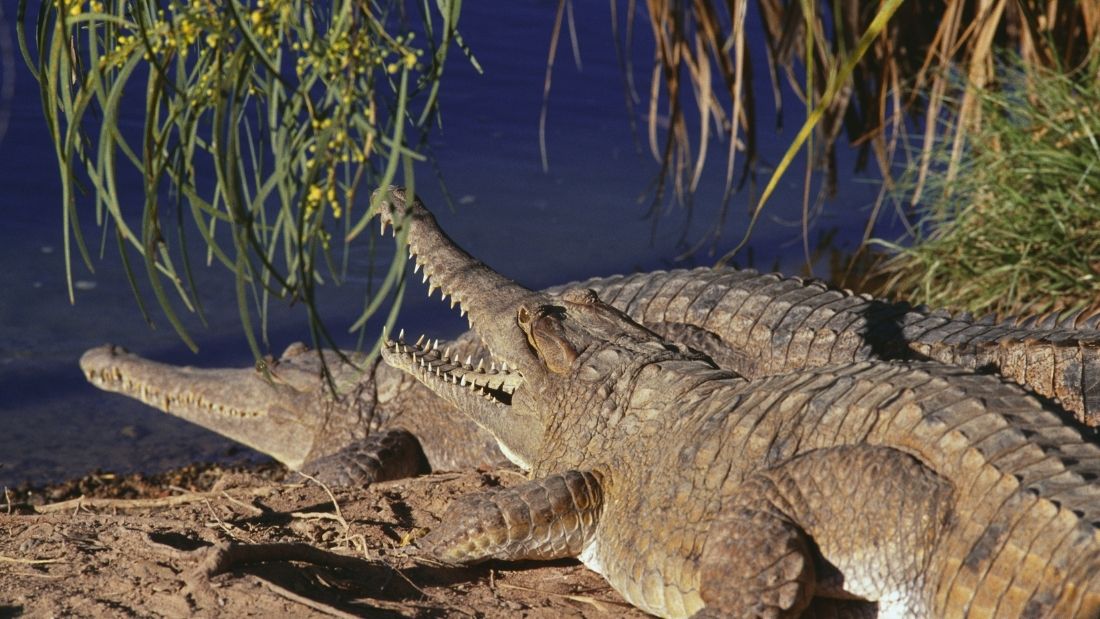
Crocodiles are more closely related to dinosaurs and birds than to other reptiles and their ancestors have lived on this planet for more than 200 million years.
Their bodies are extremely impressive, particularly their jaws, which are incredibly powerful and can bite down with a force of 3,000 pounds of pressure per square inch (psi). In comparison, a Labrador can bite down with a force of 100 psi.1O’Connell, S., 2006. Crocodile farms: is it cruel to keep these wild creatures captive?. 5 October. The Independent. Available at https://www.independent.co.uk/environment/crocodile-farms-is-it-cruel-to-keep-these-wild-creatures-captive-418794.html [Accessed 11 June 2020]. While they can bite down incredibly hard, the opening strength of their jaws is nothing in comparison. A crocodile’s jaw can be held shut with a rubber band, a technique which is ruthlessly used by poachers to capture these extraordinary creatures.
When waiting to catch their prey, crocodiles can stay underwater for up to an hour and reduce their heart rate to just two to three beats a minute.2Chilton, G., 2016. Welcome to croc country. 29 March. Australian Geographic. Available at https://www.australiangeographic.com.au/topics/wildlife/2016/03/welcome-to-croc-country/ [Accessed 9 June 2020]. When they’re underwater, transparent eyelids enable them to see so they’re able to suddenly launch themselves forward when their prey is close enough.
Crocodiles can feel pleasure and joy – they enjoy piggyback rides with their crocodile mates, playing ball and surfing waves.3Dinets, V., 2015. Play behaviour in crocodilians. Animal Behavior and Cognition. Available at http://www.animalbehaviorandcognition.org/uploads/journals/5/04.Dinets_FINAL.pdf [Accessed 9 June 2020]. Surprisingly, they are very sensitive to touch and become almost playful when ‘tickled’ by another crocodile. They are the most developed reptile on our planet and have a four-chambered heart, unlike other reptiles.
Since the twentieth century, they have faced new and very real threats which have all reduced their numbers: habitat destruction, legal hunting, poaching and entanglement in fishing nets. But now, they no longer live solely in the wild and the global goal of maximising profits ignores their natural needs and so, the magnificent crocodile is subjugated to the horrors of intensive farming.
Crocodiles are large aquatic reptiles – members of the Crocodilia family – and live in tropical regions such as Australia, Africa, the Americas and Asia. The smallest of the 23 species is the dwarf crocodile, which weighs around seven kilos and is under two metres long. The saltwater crocodile is the largest and can be as long as 6.17 metres and weigh up to 907 kg.
Regardless of adult size, crocodile hatchlings are all around 20 cm in length.
Cold-blooded, they rely on the sun to warm them and when it’s too hot, they use mud as a sun-screen to prevent dehydration. They are fascinating and astounding creatures who, now have been turned into worldwide commodities for their flesh and skin.
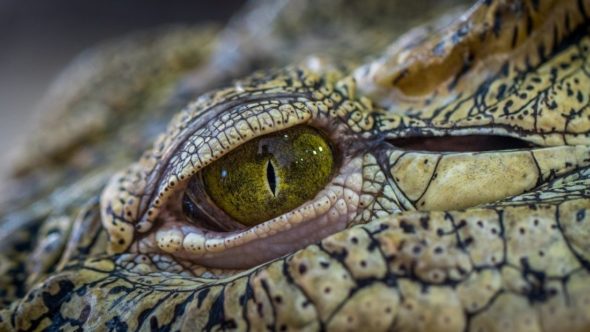
Origin and History
Crocodiles are the only living dinosaurs, the last remaining members of the Class Archosauria reptiles of the Mesozoic era. Their ancestors lived around 200 to 265 million years ago alongside Tyranosaurus rex and the massive Brontosaurus. Crocodiles lived through the Cretaceous era when the dinosaurs disappeared, survived the breakup of the ancient world when continents split and drifted across the globe and they even made it through the Ice Ages of the last two million years. Amazingly, today’s crocodiles are little different from their prehistoric relatives.
Habitat
Crocodiles live in tropical climates near freshwater habitats such as lakes, rivers, wetlands and sometimes brackish water, which is saltier than freshwater, but not as salty as the sea. However, saltwater crocodiles of Southeast Asia, Australia and the Pacific islands often live in coastal areas.
Social Groups
The social behaviour of crocodiles is difficult to study in the wild, so knowledge about this is limited.
They don’t form packs but do allow other crocodiles to lie near them. They also have a hierarchy, where the highest ranked gets to choose the best sunning and shade spaces.
Their mating season is between January and May and sexual maturity is linked to the length of the animal. Males become sexually mature at around three metres long while for females it’s between 2.5 to three metres. Males attract females by slapping their snouts in the water, bellowing, using various other vocalisations and blowing water out of their noses.
Vigilant and dedicated, crocodiles make excellent mothers and many will use the same nesting site year after year. Mothers remain close to the nest throughout the incubation period, actively defending it when necessary. For the eggs to hatch, they must be kept at a temperature of between 27 and 34 degrees – the temperature also determines the sex of the hatchlings. With climatic changes affecting temperatures globally, it’s a wonder that any survive at all.
Although crocodiles rarely move away from water, their eggs are laid in an underground nest on dry land. After laying, the female will seal the nest to secure it from predators and keep vigil for the next 90 days. When the eggs hatch below ground, the young call for their mother who is on stand-by waiting to dig them out. From here she will transport them to a nursery pool where they will immediately put into practice their innate hunting instincts. Creches are formed and although the mothers may stay around for several months, one female will sometimes take on the responsibility of looking after a hundred or so hatchlings. Some species stay with their young for up to three years.
Natural Diet
Crocodiles are carnivores and eat birds, fish, crustaceans, mammals and frogs. Big species such as the Nile Crocodile can bring down animals as big as buffalos and zebras.
As ambush hunters, they wait for their prey to come close and then lunge forward to attack. They clamp down their jaws on the prey, crush it and then swallow it whole. Crocodiles cannot chew their food and so swallow small stones to help them digest it by grinding up the contents of their stomachs. They have a very slow metabolism and can survive for months without food.
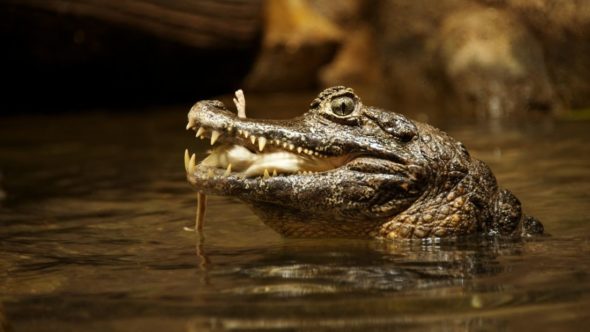
Life Expectancy
Crocodiles live on average between 50 and 75 years, depending on the species. The oldest crocodile in captivity reached the age of around 140 years. He was called Mr Freshi, a freshwater crocodile, and lived in an Australian zoo.
Predators
Hatchlings and young crocodiles have a wide range of predators, including birds such as herons, egrets and eagles, large fishes, turtles, bobcats, black bears and other crocodiles.
As they grow bigger, the risk of being eaten by another animal decreases while the risk of being killed by humans increases. The most endangered of the species is the Cuban crocodile which, mainly due to poaching, now has a population of only 4,000.
Predators of adult crocodiles, ironically, are other adult crocodiles if food sources are scarce, but also big sharks and big cats such as jaguars and leopards will hunt them, and sometimes huge snakes such as anacondas and pythons. Elephants don’t eat crocodiles but if one of their young is attacked they will certainly kill the attacker.
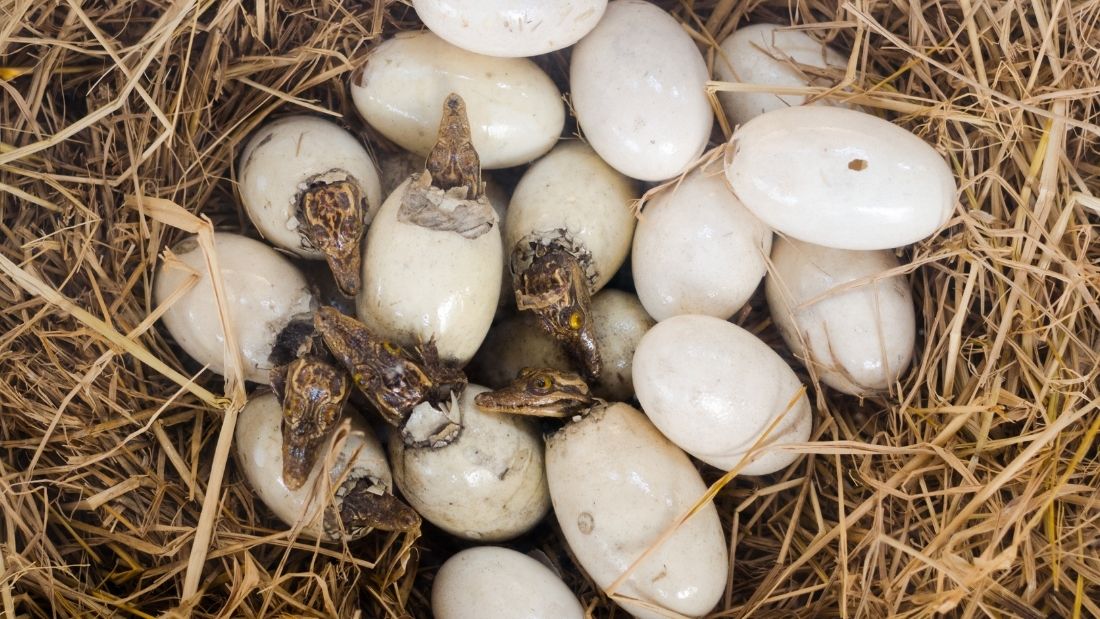
Crocodiles are bred to be exploited for their skin and meat in three ways: They are captive bred in factory farms; they are ‘ranched’ – where eggs, hatchlings or juveniles are taken from the wild and bred in farms; or they are ‘wild harvested’.1Crocodile Specialist Group, 2020.Best Management Practices for Crocodilian Farming. Available at http://www.iucncsg.org/content_images/attachments/CSG-BMP.pdf [Accessed 11 June 2020]. The sale of their skins is more profitable than their meat; which is seen as a by-product.
Due to poaching and habitat destruction, the wild crocodile population declined in the 1960s and 1970s and it was this that led to crocodile farms gaining popularity. With the flourishing demand of the crocodile skin trade in the 1950s and 1960s, many species, including the Australian saltwater crocodile (Crocodylus porosus) were hunted to the brink of extinction. It is estimated that between 270,000 and 330,000 Australian saltwater crocodiles were killed between 1945 and 1972 – 45,000 of which were hatchlings, destined for the curio trade.
Today, there are 13 crocodile farms in Australia alone and the majority of skins and meat are exported.2AgriFuture, 2017. Crocodiles. 25 May. Available at https://www.agrifutures.com.au/farm-diversity/crocodiles/ [Accessed 11 June 2020]. Farms are stocked initially from the wild and some continue to replenish their breeding and rearing stock with ‘ranched’ crocodiles. Ranching is defined as ‘the rearing in a controlled environment of specimens taken from the wild, for the purposes of trade’. Live crocodiles are captured and removed from their natural habitat and it is perfectly legal as long as the animals are taken in accordance with a management programme. The ranching restrictions that had been imposed by CITES (Convention on International Trade in Endangered Species of Wild Fauna and Flora) in 1970 due to the decline of C. porosus were lifted again in 1994, allowing both saltwater and freshwater crocodiles to be taken freely.
Crocodiles are not widely farmed in the UK but in 2006, a farmer from Cambridge made headlines as the first person in the country to farm them.3Rigby, N., 2006. Crocodile meat for Fenland farm. 26 May. BBC. Available at http://news.bbc.co.uk/1/hi/england/cambridgeshire/5017388.stm [Accessed 4 June 2020]. The farmer uses fallen chickens and pigs and other animal waste from intensive factory farms as food for the animals, who are slaughtered and sold commercially.
Thailand is the world leader in crocodile farming, with around one million animals on 20 mega farms and around 1,000 farms in total.4France 24, 2016. Thailand: inside a crocodile “megafarm”. Available at https://newsvideo.su/video/4811522 [Accessed 4 June 2020]. The biggest farm has around 150,000 animals5Reuters, 2017. Thailand’s thriving industry in crocodile farms. 1 July. Available at https://uk.reuters.com/article/us-thailand-crocodiles/thailand-home-to-some-of-worlds-biggest-crocodile-farms-idUKKBN19L1MT [Accessed 11 June 2020]. One of these huge farms is only a two hour drive from Bangkok. Every morning, the crocodiles’ eggs are collected and placed in a specially built incubator room. After 45 days the eggs start to hatch, with the big farms hatching around 20,000 baby crocodiles each year.
While crocodile farming is growing around the world, there have never been so few in the wild and they have now been listed as an endangered species.
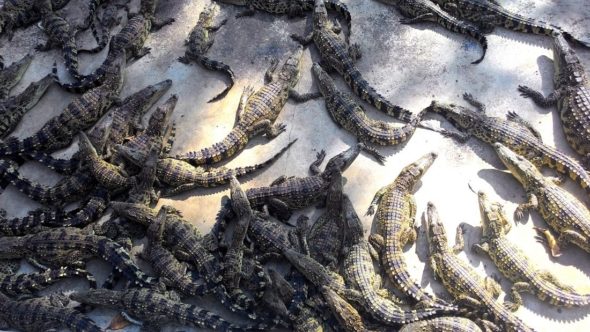
Life on crocodile farms
On crocodile farms, animals live in small enclosures crammed in with dozens of others. There may be a water pool for swimming but the overcrowding ensures that only the highest ranking crocodiles will get to fulfil their natural need for water.6O’Connell, S., 2006. Crocodile farms: is it cruel to keep these wild creatures captive?. 5 October. The Independent. Available at https://www.independent.co.uk/environment/crocodile-farms-is-it-cruel-to-keep-these-wild-creatures-captive-418794.html [Accessed 11 June 2020].
Farmed crocodiles may look calm and content but the practised eye of a reptile scientist can see the signs of severe distress which the animals display and have to endure for several years until they reach slaughter age. The pools which are supposedly there for the animals’ welfare rarely get cleaned and this dirty water leads to infections of wounds caused by fighting between stressed crocodiles.
As with so many other animals, crocodiles rarely fight among themselves in the wild and often allow other crocodiles to live nearby. On farms, 90 per cent of injuries are directly related to the oppressive environment. The cramped conditions inevitably drive aggressive behaviour and they also develop deformities and abnormalities through lack of space to either walk or swim.
Breeding
Female crocodiles lay between 10 to 60 eggs at a time and the incubation period lasts between 55 and 110 days. Young crocodiles don’t mature until they are four to 15 years old.
Eggs and hatchlings
In the wild, some crocodile species stay with their mothers for several years but on factory farms, these maternal instincts are entirely denied. Eggs are regularly removed and placed in incubation rooms. These ‘thefts’ even happen to wild crocodiles when humans take eggs to restock their farms.
Mutilations
CITES requires a secure marking system for breeding stock. This includes painful scute-clipping (where scutes (bony scales) are cut out from the animal’s tail), tail tags and webbing tags, where metal clips are attached to the crocodile’s webbed feet.1Crocodile Specialist Group, 2020.Best Management Practices for Crocodilian Farming. Available at http://www.iucncsg.org/content_images/attachments/CSG-BMP.pdf [Accessed 11 June 2020].
Some countries allow teeth-clipping of the crocodiles’ sharpest front teeth, in an attempt to decrease injuries – and it is done without anaesthetic.
Disease
Under intensive farming conditions, crocodiles are extremely sensitive to stress which can trigger diseases and lead to death.7Huchzermeyer, F.W., 2002. Diseases of farmed crocodiles and ostriches. Revue scientifique et technique-Office international des épizooties, Available at https://www.doc-developpement-durable.org/file/Elevages/autruches&Emeus/Maladies/Diseases%20of%20farmed%20crocodiles%20and%20ostriches.pdf [Accessed 12 June 2020].
Crocodiles need to keep their body temperature between 28 and 33 degrees Celsius. In nature, water pools, mud baths, sun and shade help with temperature regulation. On intensive farms, these natural regulators are not available and crocodiles’ lack of ‘thermoregulation’ leads to stress due to overheating and weakened immune systems due to their body temperature dropping too low.7Huchzermeyer, F.W., 2002. Diseases of farmed crocodiles and ostriches. Revue scientifique et technique-Office international des épizooties, Available at https://www.doc-developpement-durable.org/file/Elevages/autruches&Emeus/Maladies/Diseases%20of%20farmed%20crocodiles%20and%20ostriches.pdf [Accessed 12 June 2020].
Hatchlings and juveniles have many predators in the wild and therefore they prefer to hide. Not being able to do that on intensive farms is another source of stress for them.
Unhygienic conditions and the spread of disease through being fed dead animals (‘fallen stock’) from other farms, are other sources of disease.
Crocodile pox, caused by the parapoxvirus, causes lesions on the crocodile’s body. It has not been found in crocodiles in the wild yet and vets suggest it is caused by the stressors of intensive farming like handling, transport and inappropriate water temperature.8Afonso, C.L., Tulman, E.R., Delhon, G., Lu, Z., Viljoen, G.J., Wallace, D.B., Kutish, G.F. and Rock, D.L., 2006. Genome of crocodilepox virus. Journal of virology. Available at https://www.ncbi.nlm.nih.gov/pmc/articles/PMC1472061/ [Accessed 12 June 2020]. 9Shilton, C.M., Jerrett, I.V., Davis, S., Walsh, S., Benedict, S., Isberg, S.R., Webb, G.J., Manolis, C., Hyndman, T.H., Phalen, D. and Brown, G.P., 2016. Diagnostic investigation of new disease syndromes in farmed Australian saltwater crocodiles (Crocodylus porosus) reveals associations with herpesviral infection. Journal of Veterinary Diagnostic Investigation. Available at https://journals.sagepub.com/doi/full/10.1177/1040638716642268 [Accessed 15 June 2020]. 10Wildlife Health Australia, 2020. Disease of concern in wild Australian crodociles. Available at https://www.wildlifehealthaustralia.com.au/Portals/0/Documents/FactSheets/Reptiles/Diseases_of_concern_in_wild_Australian_crocodiles.pdf [Accessed 11 June 2020]. There is no treatment or vaccination available and it spreads readily, but the mortality rate is low, unless the lesions become infected.
Other common diseases are adenoviral hepatitis, Dermatophilosis and salmonellosis.
Leading reptile scientist Dr Clifford Warwick’s big worry regarding the consumption of crocodiles is the risk it poses to human health. Wild animals carry a range of pathogens, some of which can be deadly to humans and have the potential to cause a global pandemic if they enter the food chain.6O’Connell, S., 2006. Crocodile farms: is it cruel to keep these wild creatures captive?. 5 October. The Independent. Available at https://www.independent.co.uk/environment/crocodile-farms-is-it-cruel-to-keep-these-wild-creatures-captive-418794.html [Accessed 11 June 2020].
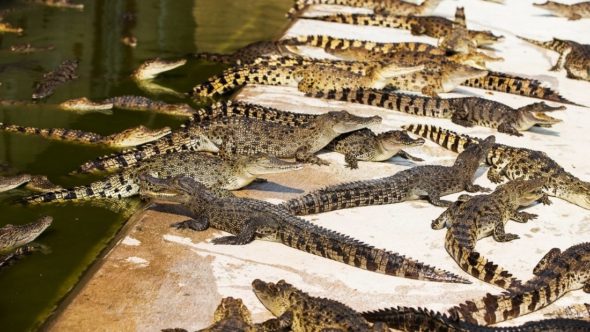
Drugs
The most commonly used antibiotic on crocodile farms is oxytetracycline.7Huchzermeyer, F.W., 2002. Diseases of farmed crocodiles and ostriches. Revue scientifique et technique-Office international des épizooties, Available at https://www.doc-developpement-durable.org/file/Elevages/autruches&Emeus/Maladies/Diseases%20of%20farmed%20crocodiles%20and%20ostriches.pdf [Accessed 12 June 2020].
Crocodiles reach slaughter weight when they are six to eight feet long, at around two to three years old.1AgriFuture, 2017. Crocodiles. 25 May. Available at https://www.agrifutures.com.au/farm-diversity/crocodiles/ [Accessed 11 June 2020]. Their brains are fully developed and are encased in two layers of bone for protection. This means it is very difficult to stun them with a captive bolt – a short steel bolt fired from a gun to penetrate the skull but which remains attached to the gun. The angle needs to be perfect in order to hit the part of the brain which has only one layer of protective bone.2O’Connell, S., 2006. Crocodile farms: is it cruel to keep these wild creatures captive?. 5 October. The Independent. Available at https://www.independent.co.uk/environment/crocodile-farms-is-it-cruel-to-keep-these-wild-creatures-captive-418794.html [Accessed 11 June 2020]. Slaughterers are rarely as skilled, or as knowledgeable or concerned as they should be about this and the result is often brain damage and a long, painful death.
Under UK legislation, animals are required be stunned before slaughter but because the process is difficult to achieve and there are no inspections, a high number of animals are killed fully conscious.
Slaughter methods are brutal everywhere. In Australia, legislation demands that farmers electrically stun the animals, which supposedly makes them fall unconscious for several minutes. While the crocodile is immobilised, the slaughterer grades the skin, cuts the animal to bleed out and piths the brain with a short steel rod. This essentially entails scrambling the brain by swirling the rod around inside the skull – it prevents the animal from thrashing around and potentially injuring workers.
In Asia, where much crocodile leather originates, crocodiles are ineffectively stunned with a car battery before having a blade stabbed through the top of their skull to kill them. This method is extremely inaccurate and many crocodiles will be left brain-damaged and in pain. The stabbed crocodiles are then inflated with air and sliced head to tail to remove their skin. They could be conscious for the entire painful process.3Peta UK. 2021. Urge LVMH to Shed Fur and Exotic Skins From Louis Vuitton and Other Brands. PETA UK. Available: https://secure.peta.org.uk/page/35626/action/1 [Accessed 5 March 2021].
Another method is to cut off the crocodile’s head with a machete. It takes an hour until the animal has lost consciousness.4Warwick, C., Frye, F.L. and Murphy, J.B. eds., 2013. Health and welfare of captive reptiles. Springer Science & Business Media. New York. Available at https://www.researchgate.net/profile/Gordon_Burghardt/publication/288991802_Effects_of_ontogenetic_processes_and_rearing_conditions/links/5be1b08aa6fdcc3a8dc264af/Effects-of-ontogenetic-processes-and-rearing-conditions.pdf [Accessed 11 June 2020]. An hour of unbearable suffering and pain.
Other slaughterers sever the spinal cord with a chisel at the back of the skull. It can take up to eight hits with a mallet before the chisel can penetrate and even when it does, the crocodile is merely paralysed. Axes, mallets or even baseball bats are used to smash crocodiles’ heads in to try to effect a kill.
Crocodile industry
Around 1.33 million crocodiles were killed each year worldwide from 2007 to 2010 and over 1.5 million in subsequent years.5Crocodile Specialist Group, 2020. Farming and the crocodile industry. Available at http://www.iucncsg.org/pages/Farming-and-the-Crocodile-Industry.html [Accessed 11 June 2020]. Their meat is a by-product of producing their expensive skins. In 2015, almost 770 tonnes of crocodile meat was traded.6Caldwell, 2017. World trade in crocodilian skins 2013-2015. UNEP. Available at https://www.unep-wcmc.org/system/dataset_file_fields/files/000/000/479/original/World_Trade_in_Crocodilian_Skins_2013-2015.pdf?1507799294 [Accessed 11 June 2020].
China has the biggest demand for crocodile meat, with some parts of the animals’ bodies being used in pharmaceuticals and traditional Chinese medicine. Crocodiles are legally exported from 30 different countries around the world5Crocodile Specialist Group, 2020.Best Management Practices for Crocodilian Farming. Available at http://www.iucncsg.org/content_images/attachments/CSG-BMP.pdf [Accessed 11 June 2020].
The US traded 481,000 skins of Alligator mississippiensis in 2013, and similar numbers in other years, which makes them another big producer of crocodile meat too.6Caldwell, 2017. World trade in crocodilian skins 2013-2015. UNEP. Available at https://www.unep-wcmc.org/system/dataset_file_fields/files/000/000/479/original/World_Trade_in_Crocodilian_Skins_2013-2015.pdf?1507799294 [Accessed 11 June 2020]. Thailand exports most of its vast amounts of crocodile meat to China (France 24, 2016). The most lucrative part of all crocodile farming is their skins and just one crocodile skin can be sold for roughly USD 300.
Australia accounts for just over one per cent of the worldwide production of crocodile meat.1AgriFuture, 2017. Crocodiles. 25 May. Available at https://www.agrifutures.com.au/farm-diversity/crocodiles/ [Accessed 11 June 2020]. Trade from African countries is increasing by 22 per cent per year. Zimbabwe is the biggest producer of crocodile meat in Africa, while Kenya exports 85 per cent of its production to China, Hong Kong and Taiwan.7Njeru,G., 2016. Croc of gold: Kenya’s booming crocodile farm industry. 1 September. BBC. Available at https://www.bbc.co.uk/news/business-37218790 [Accessed 11 June 2020].
UK crocodile meat market
Crocodile meat is not widely eaten in the UK. Viva!’s long-running campaign against ‘exotic’ meats stopped Somerfield from selling crocodile meat nationwide.
In the past, the supermarket chain Iceland sold exotic meat packs, including crocodile meat, after it was featured on the TV show I’m a celebrity… get me out of here8Bamford, V., 2014. Iceland rolls out £10 pack of crocodile, kangaroo and ostrich meat. The Grocer. 7 November. Available at https://www.thegrocer.co.uk/buying-and-supplying/iceland-rolls-out-10-pack-of-crocodile-kangaroo-and-ostrich-meat/373398.article [Accessed 12 June 2020]. Some restaurants and online outlets also sell ‘exotic’ meat from numerous animal species, often imported from South Africa.
According to Zimbabewean crocodile trader, Papagenda Holdings, Europe’s demand for crocodile meat has increased and totalled 256 tonnes in 2017.9Karombo, T., 2018. Lucrative European demand for Zimbabwean croc meat and skins. Available at https://www.iol.co.za/business-report/international/lucrative-european-demand-for-zimbabwean-croc-meat-and-skins-14080387 [Accessed 12 June 2020].
Viva! campaigns against the sale of ‘exotic meats’ and also the factory farming of animals such as ostrich, emu and crocodile. Our campaigns have led to all the major supermarkets withdrawing kangaroo, ostrich and crocodile meats from sale – a major blow to this relatively new animal abuse industry.
Sadly, meat from these wild animals is still on sale in small chains of pubs and in some restaurants and shops. Please let Viva! know of any outlet selling ‘exotic’ meat, so we can contact them.
Walkabout Inns
Walkabout Inns – a small chain of Australian ‘theme’ pubs – are offering a range of ‘exotic’ meats on their menus. Please boycott these pubs.
Viva! campaigned against Walkabout Inns which are all around the UK.
If you live near a branch of Walkabout, contact Viva! and we will send you free campaign leaflets to distribute. Write to or phone the branch and urge them to withdraw ‘exotic’ meats from the menu.
Never buy any ‘exotic’ meat and complain whenever you see it on sale!
Supermarket Viva! Victories
Viva! has won the fight to stop ‘exotic’ meats becoming established in Britain. Crocodile, bison, camel, kangaroo and ostrich have been dropped by Sainsbury’ s, Tesco, Morrisons, Somerfield and Booker cash and carry, as a result of our long-running campaign. We began the campaign back in 1997, succeeding in getting five major chains to drop ‘exotic’ meats. Years later, Morrisons, Sainsbury’s, Iceland and Tesco tried reintroducing some ‘exotic’ meats and Viva! again flew into action. All of them dropped the meats. At the time of writing, no UK supermarket sells ‘exotic’ meats.




